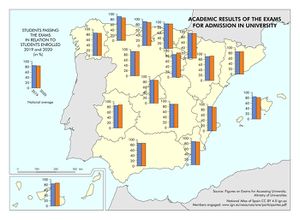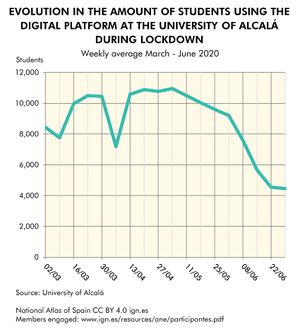Talk:Education (COVID-19 monograph)
The COVID-19 pandemic in Spain. First wave: from the first cases to the end of June 2020
Monographs from the National Atlas of Spain. New content
Thematic structure > Social, economic and environmental effects > Education

The impact of the first wave of the COVID-19 pandemic on the different levels of education in Spain was very severe. Lockdown brought about a sharp change in teaching-learning methods from the first stages of school up to university degrees and postgraduate courses.
A new virtual relationship between teachers/professors and students replaced the usual face-to-face teaching. The availability of access to information and communication technologies (ICT) for students enabled finishing the school year in July despite the exceptional situation.
It is difficult to accurately gauge the real incidence and effects of lockdown on teachers/professors and students who were forced to adapt to the circumstances and continued to make progress with the set curriculum using online connections at the different levels of education. However, the lack of personal and direct contact with each other may have had an impact on learning deficits in the different levels of education. Future research may reveal whether the impact was even more far-reaching than is currently perceived.
This chapter shows only those facts for which quantitative data are available. First, the extent of lockdown on the school/university community. Second, two indicators on the academic performance of university students are shown. Finally, data on the use of ICT that enabled online teaching are assessed.
The amount of students in lockdown is shown split into the different levels of education, i.e. infant and primary education, secondary education (compulsory secondary education, baccalaureate and vocational training) and university education (undergraduate, master and postgraduate). 10,017,000 students dropped out of the traditional face-to-face education system in Spain during the first wave of the pandemic and turned to online teaching. The majority of students were in compulsory education levels, i.e. infant, primary and compulsory secondary education, which accounted for over 66%. Further 1,400,000 students in baccalaureate and vocational training were also in lockdown. And another 1,400,000 university students switched to online learning. Teachers and professors shall also be added to this amount of students, i.e. 848,000 teachers and professors in the different levels of education.
It is difficult to gauge the influence of lockdown on the change in academic performance. However, it is interesting to observe the nuances shown by data from the Ministry of Universities in relation to two of the academic performance indicators.
Students report on the learning acquired over a long period of school time at the Exams for Admission in University. These exams are officially called ‘Baccalaureate Assessment for Admission in University’ in some regions and ’Assessment for Admission in University’ in some others. The academic results of these exams show an uneven behaviour, although no striking differences are to be observed either geographically (between territories) or temporally (comparing the 2018-2019 and 2019-2020 academic years). No negative effects on the results of primary and secondary schools may be concluded due to the halt of face-to-face teaching during lockdown. The academic performance of university students shows that the results of the 2019-2020 academic year were better than those from the previous year in all regions and in both public and private universities. It shall be noted that e-learning was able to successfully replace face-to-face learning, thus avoiding a significant deficit that would have occurred in the absence of ICT.
There is no complete and comparable data on the role played by ICT on online teaching. Therefore, a specific example on a university digital platform is included in order to show what happened in general at university in Spain during lockdown.
-
 Map: Students in infant and primary education in lockdown. 2019-2020. Spain. PDF. Data. Interactive version.
Map: Students in infant and primary education in lockdown. 2019-2020. Spain. PDF. Data. Interactive version. -
 Map: Students in secondary education, baccalaureate, vocational training and special scheme in lockdown. 2019-2020. Spain. PDF. Data. Interactive version.
Map: Students in secondary education, baccalaureate, vocational training and special scheme in lockdown. 2019-2020. Spain. PDF. Data. Interactive version.
|
Use of the digital platform at the University of Alcalá during lockdown
There were 1,731 professors, 16,347 students in 46 degrees and 4,631 students in 60 master studies at the University of Alcalá during the 2019-2020 academic year. A daily average of 800 professors and nearly 11,000 students made use of the digital platform to continue teaching once face-to-face lectures were suspended on 14 March 2020. The amount of online lectures stayed at around 1,000 during the second half of the academic year, reaching a peak of 1,400 on 16 March 2020. Users (amount of connections to the digital platform) and unique users (amount of people who accessed the digital platform once or several times) show a similar trend, i.e. over 10,000 for the former and over 7,000 for the latter in mid-April. These figures were only interrupted during the Easter holidays in the first days of April. |
Co-authorship of the text in Spanish: Olga De Cos Guerra, Pedro Reques Velasco and José Sancho Comíns. See the list of members engaged
You can download the complete publication The COVID-19 pandemic in Spain. First wave: from the first cases to the end of June 2020 in Libros Digitales del ANE site.





